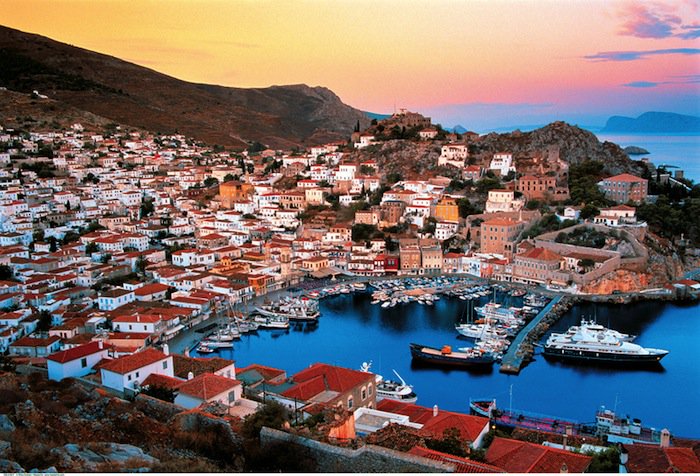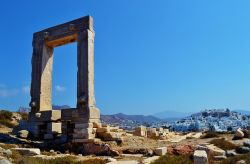-
News
Greece - Greek Islands
-

A useful travel guide to Hydra
13-06-2017 11:25A whaleback ridge looming from the sea, Hydra shot to fame in 1956 as the location for A Girl in Black, directed by Michael Cacoyannis, with an extra filip in 1957 for hosting Boy on a Dolphin, starring Sophia Loren.
Soon various foreign personalities (including Leonard Cohen) bought and restored property here, joining prominent Greeks who had long appreciated the island’s charms. Sumptuous mansions and humbler vernacular homes arrayed amphitheatrically around the marble-quayed harbour date from the 18th and 19th centuries, when Hydriot seafaring prowess brought great wealth. Despite its high-profile reputation, and the mid-day arrival of “One-Day Saronic Cruises”, the island remains endearingly time-warped: as a listed architectural reserve, all new construction is (theoretically) banned, and the town (though not the remoter parts of Hydra where pick-up trucks and 4WDs are seen) remains blissfully free of motor vehicles except for two small fire trucks and a few miniature rubbish trucks – photogenic donkeys (or mules) do most haulage. The clip-clop of the beasts' hooves on marble pavement and their drovers' cries are very much part of the soundtrack here.
Getting there
Ferries: From Aktí Miaoúli quay in Piraeus, gate E8, hydrofoils or catamarans sail for Hydra (Ýdra in Greek) almost hourly in peak season, but typically just three times daily October-May. Hellenic Seaways (hellenicseaways.gr) provides service all year; online bookings are best, pick up tickets at its booth on Aktí Miaoúli. During high season Hellas Speed Cat (speedcat.gr) also sails twice daily (once only Tue/Wed) for about the same price.
If – and only if – you're on a driving tour of the Peloponnese, there is a better alternative: Hydra Lines' small, very inexpensive boats Freedom II and Freedom III, which ply up to 12 times daily in season (less on Sun) from Metóhi Thermisías, a tiny port (with no bus service) immediately opposite Hydra on the Peloponnese, 25km east of Kranídi or 25km west of Galatás. Leave your car in the parking lot with the Hydriots' vehicles; see current schedules at hydralines.gr. The Freedom boats have competition now from the Metoxi Express (hydracelebrity.gr), travelling 6–7 times daily in each direction from early May to early September, dropping to 3 daily during off-season. Prices on the two lines are comparable; 15min journey time.
Getting around
Once on Hydra, it’s shanks pony or taxi-boats – no buses, no scooters for hire. Baggage is transferred to the better hotels by hand-cart, while taxi-boats (€3 one way) ply as far as Plákes Vlyhoú with its hotel from early in the season. Only from late May to early September are little scheduled boats to Bísti beach (€10 one way) at all reliable, leaving at 11am–noon and returning around 4pm. If you choose to charter one of these specially, it's a very expensive undertaking unless you get a group together.
What to see and do
No great museums or ancient sites – the main thing here is to stroll about, soaking up the atmosphere, especially early or late when the town is cruise-free.
House-museums
Some mansions once belonging to ships’ captains have become museums. The best of these is the Lazaros Koundouriotis inland and up from Platía Vótsi on the westerly hillside (Apr–Oct 10am-2pm and additionally in summer 5.30pm-8.30pm Tue–Sun; €4). The building bids to outshine its contents, with a marble carved-relief wellhead (next to a foot-washing basin), coffered wood ceilings and massive ovens in the basement kitchen. But there are many worthwhile paintings by Periklis Byzantios (1893–1972), first director of the nearby Fine Arts School (in another mansion), and his son Dikos (1924–2007) – post-cards and prints of their works sold in the gift shop. Finally, you're directed upstairs to the ethnographic section: well-labelled, often sumptuous pan-Hellenic weavings, costumes, jewellery, belts, buckles and pottery.
The less compelling Historical Archives Museum on the east quay (daily 9am-4pm, also July-Aug 7.30-9.30pm; €5), displays costumes, old gravures and artefacts from the War of Independence, as well as hosting temporary exhibitions.
Hiking
Outside summer, Hydra is ideal for walkers; either the 1:25,000 Anavasi 'Hydra 10.40' topographic map (anavasi.gr) or the terrain 1:20,000 Terrain '395 Hydra' one (terrainmaps.gr) makes route-finding easier. Neither product is perfect, but one or other is indispensable, and sold locally. A map-placard on the main quay details four marked, recognised long-distance routes, indicated by small black-on-yellow signs and black-and-yellow paint blazes or tree-markers (yellow, black-rimmed metal squares) once underway. You don’t need a map for the coastal path to Vlyhós (35min from port) and beyond to Plákes Vlyhoú (50min away), or up the steep stairs to hilltop Profítis Ilías monastery above town.
But one is certainly useful for the tough, 90-minute hike to Limnióniza beach on the south coast, or (more ambitiously) to the cape and monastery at Zoúrvas in the north-east (4hr one way, best arrange a boat transfer back).
The grand-daddy of all Hydriot hikes, though, is the longitudinal island traverse southwest to the bays of Ágios Nikólaos or Bísti. Matters prove straightfoward as far as Plákes Vlyhoú and the Palamída boatyard 20 minutes later, but then it gets trickier as you head inland from there, forsaking views of chapel-stooked islets, yachts and the straits with Dokós.
Beaches
Hydra is not known for its beaches – they can’t compare with those of the Aegean or Ionian islands. Besides pebbly Limnióniza, the closest recommendable ones to town are Avláki (shingle), just 10 minutes' walk west towards Kamíni, Kastéllo (officially Mikró Kamíni, beyond Kamíni), currently with no facilities, Vlyhós (also shingle), with sunbeds, two tavernas and the possibility of swimming out to an islet, and Plákes Vlyhoú (15min past Vlyhoú), small pebbles despite the Greek name ('Slabs'), with more sunbeds and a decent taverna, reviewed below. Bísti (pebbles, seasonal sunbed concession) and Ágios Nikólaos (200m of fine pebbles and sand) at the south-western tip are better, but arduous to hike to (see directions above); most people go by taxi-boat in at least one direction (one-way fares quoted).
by Marc Dubin (Telegraph)
-
Top bews!
-
Relative articles













